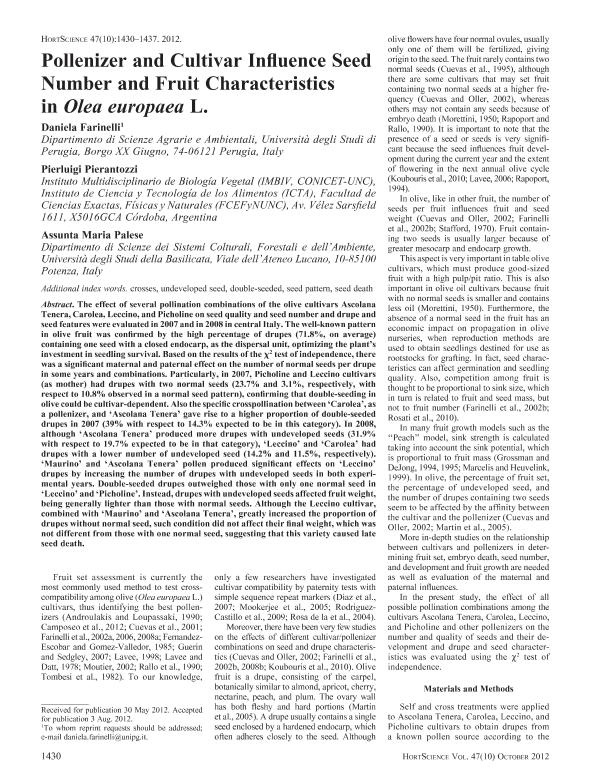Mostrar el registro sencillo del ítem
dc.contributor.author
Farinelli, Daniela
dc.contributor.author
Pierantozzi, Pierluigi

dc.contributor.author
Palese, Assunta Maria
dc.date.available
2023-05-15T11:23:27Z
dc.date.issued
2012-10
dc.identifier.citation
Farinelli, Daniela; Pierantozzi, Pierluigi; Palese, Assunta Maria; Pollenizer and Cultivar Influence Seed Number and Fruit Characteristics in Olea europaea L.; American Society for Horticultural Science; Hortscience; 47; 10; 10-2012; 1430-1437
dc.identifier.issn
0018-5345
dc.identifier.uri
http://hdl.handle.net/11336/197441
dc.description.abstract
The effect of several pollination combinations of the olive cultivars Ascolana Tenera, Carolea, Leccino, and Picholine on seed quality and seed number and drupe and seed features were evaluated in 2007 and in 2008 in central Italy. The well-known pattern in olive fruit was confirmed by the high percentage of drupes (71.8%, on average) containing one seed with a closed endocarp, as the dispersal unit, optimizing the plant's investment in seedling survival. Based on the results of the x2 test of independence, there was a significant maternal and paternal effect on the number of normal seeds per drupe in some years and combinations. Particularly, in 2007, Picholine and Leccino cultivars (as mother) had drupes with two normal seeds (23.7% and 3.1%, respectively, with respect to 10.8% observed in a normal seed pattern), confirming that double-seeding in olive could be cultivar-dependent. Also the specific crosspollination between 'Carolea', as a pollenizer, and 'Ascolana Tenera' gave rise to a higher proportion of double-seeded drupes in 2007 (39% with respect to 14.3% expected to be in this category). In 2008, although 'Ascolana Tenera' produced more drupes with undeveloped seeds (31.9% with respect to 19.7% expected to be in that category), 'Leccino' and 'Carolea' had drupes with a lower number of undeveloped seed (14.2% and 11.5%, respectively). 'Maurino' and 'Ascolana Tenera' pollen produced significant effects on 'Leccino' drupes by increasing the number of drupes with undeveloped seeds in both experimental years. Double-seeded drupes outweighed those with only one normal seed in 'Leccino' and 'Picholine'. Instead, drupes with undeveloped seeds affected fruit weight, being generally lighter than those with normal seeds. Although the Leccino cultivar, combined with 'Maurino' and 'Ascolana Tenera', greatly increased the proportion of drupes without normal seed, such condition did not affect their final weight, which was not different from those with one normal seed, suggesting that this variety caused late seed death.
dc.format
application/pdf
dc.language.iso
eng
dc.publisher
American Society for Horticultural Science

dc.rights
info:eu-repo/semantics/openAccess
dc.rights.uri
https://creativecommons.org/licenses/by-nc-sa/2.5/ar/
dc.subject
crosses
dc.subject
undeveloped seed
dc.subject
double-seeded
dc.subject
seed pattern
dc.subject.classification
Agronomía, reproducción y protección de plantas

dc.subject.classification
Agricultura, Silvicultura y Pesca

dc.subject.classification
CIENCIAS AGRÍCOLAS

dc.title
Pollenizer and Cultivar Influence Seed Number and Fruit Characteristics in Olea europaea L.
dc.type
info:eu-repo/semantics/article
dc.type
info:ar-repo/semantics/artículo
dc.type
info:eu-repo/semantics/publishedVersion
dc.date.updated
2023-05-12T16:50:49Z
dc.journal.volume
47
dc.journal.number
10
dc.journal.pagination
1430-1437
dc.journal.pais
Estados Unidos

dc.description.fil
Fil: Farinelli, Daniela. Università di Perugia; Italia
dc.description.fil
Fil: Pierantozzi, Pierluigi. Consejo Nacional de Investigaciones Científicas y Técnicas. Centro Científico Tecnológico Conicet - Córdoba. Instituto Multidisciplinario de Biología Vegetal. Universidad Nacional de Córdoba. Facultad de Ciencias Exactas Físicas y Naturales. Instituto Multidisciplinario de Biología Vegetal; Argentina
dc.description.fil
Fil: Palese, Assunta Maria. Universita` Degli Studi Della Basilicata; Italia
dc.journal.title
Hortscience

dc.relation.alternativeid
info:eu-repo/semantics/altIdentifier/url/https://journals.ashs.org/hortsci/view/journals/hortsci/47/10/article-p1430.xml
dc.relation.alternativeid
info:eu-repo/semantics/altIdentifier/doi/http://dx.doi.org/10.21273/HORTSCI.47.10.1430
Archivos asociados
